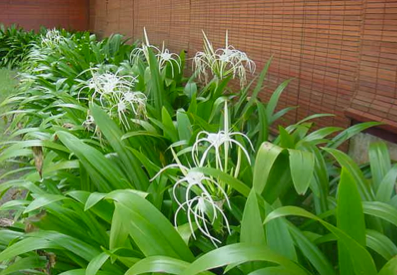Tembaga Suasa
| Tembaga Suasa | |
| Scientific Name | Crinum asiaticum L |
| Common name | Pokok bakung |
| Family | Amaryllidaecae |
 |
|
{slider=Geographical & Distribution}
Found in many countries like Malaysia, Singapora, India and West Solomon Island.
{/slider}
{slider=General Appearance}
Bulbous herb.
{/slider}
{slider=Chemical Contents}
(+)-siculine, 1-epijosephinine , 7-methoxycrinamabine, 2-O-acetylcrinamabine, 3-O-acetyl-8-O-demethylmaritidine, 2-O-acetylbulbisine, and 1-O-acetylbulbisine. In addition, dihydrovittatine and 8-O-demethyloxomaritidine (Chen CK et al 2011)
{/slider}
{slider=Traditional Uses}
To relieve teeth: Scorch the leaves over the a fire (pupuk) onto affected area.
To treat dizziness: Scorch the leaves over a fire and wrap it on the head
To treat joint and knee pains: Crush the leaves and rap it onto the affect area with the scorced leaves. (THNP)
Treatment of injury, inflamed joints. Leaves as rheumatic remedy and to relieve local pain.
The oiled and heated leaves are useful for stanger wounds by poisoned arrows, bites and sitting (Indonesia)
Poultice of the leaves is applied to swelling, swollen, joints and Lumbago pains and in case of headace and fever.The leaves are also emollient (Malaysia).
Leaves are used to treat skin diseases and inflammation, ulcer and swelling, Seed as purgative (North East Solomon Island).(Ilavenil S. et al 2010).
{/slider}
{slider=Pharmacology}
Antibacteria Activities
Aqueous and ethanol extracts from the leaves of Crinum asiaticum plants were investigated for their antibacterial activity against gram negative bacteria Pseudomonas aeruginosa (ATCC10031) Klebsilla pneumoniae (ATCC 10031) and Escherichia coli (ATCC 25922) and gram positive bacteria Staphylococcus aureus (ATCC 11632) and Bacillus subtilis (ATCC 23859) using the agar well diffusion, disc diffusion and broth dilution methods. These extract ranged between 0.5 -1.5 mg/ml.
The patterns of inhibition varied with the plant extract, the solvent used for extraction, and the organism tested. The different concentration of ethanol extract was significantly differed when compare to their aqueous extract. The maximum zone of inhibition and minimum inhibitory concentration (MIC) was found to be 1.5mg/ml. The minimum inhibitory concentrations (MIC) value of the ethanol extract of Crinum asiaticum were in the range from 0.187 mg/ml to 0.375 mg/ml. Phytochemical analysis, more than 22 compounds have been identified by Gas chromatography with mass spectrophotometry, n-Hexadecanoic acid (22.44%), 9, 12, 15-octadecatrienoic acid (15.42%), 9, 12-octadecadienoic acid (14.78%), 9, 10–Anthracenedione 2-amino (7.65%) and phytol (7.43%) are the major present components. The leaf of Crinum asiaticum is a natural source of antibacterial compounds.(Ilavenil S et al, 2010)
Antibacterial effect of Crinum asiaticum bulb extract (1mg/disc) was tested on four Gram- positive and six Gram-negative bacteria by disc diffusion method using kanamycin (30 ìg/disc) as standard antibiotic disc. The bulb extract (250-1000mg/disc) showed significant zone of inhibition against all Gram-positive and Gram-negative bacteria ranging from 12-14 mm in diameter. Antioxidant potential of the same extract was evaluated by 2,2-diphenyl-1-picrylhydrazyl (DPPH) scavenging method. The extract showed remarkable free radical scavenging effect (95.96%) providing the IC50 value of 5.62 for the bulb extract and 5.46 for ascorbic acid (standard antioxidant) at the concentration of 1000 ìg/ml. The bulb extract was found to be (LC50 value 94.06 μg/ml) in Brine-Shrimp lethality test (Rahman MA. et al 2011)
Antinociceptive Effect:
The methanol extract of Crinum asiaticum bulb was evaluated for its antinociceptive properties on the pain induced by acetic acid and formalin in Swiss albino mice. The bulb extract at a dose of 1, 1.5 and 2 g/kg produced an inhibition of 40.71, 56.42 and 68.57% on pain induced by acetic acid and at a dose of 1.5g/kg & 2g/kg produced an inhibition of 60.0 and 67.0% on that induced by formalin. The anti‐inflammatory activity of the same extract was estimated volumetrically by measuring the mean increase in hind paw volume of carrageenan‐induced Wistar albino rat with the help of plethysmometer. Oral administration of bulb extract at a dose of 1.5g/kg & 2g/kg showed the highest inhibition 52.56% and 47.37%, respectively, at the 3rd hour of administration whereas at a dose of 1g/kg showed 37.5% inhibition at the 4th hour. Diclofenac sodium at a dose of 40 mg/kg was used as a standard drug in the inhibition of acetic acid and formalin induced pain as well as in carrageenan‐induced paw edema (Rahman MA. et al 2011).
Ethyl acetate and alkaline ethylacetate soluble fractions of the bulbs of Crinum asiaticum var. japonicum showed significant cytoxicity ED 1.1 and 0.9 ug/mL respectively against Lewis lung carcinoma tumor cells. A new pyrrolophenanthridone alkaloid, criasiaticidine A, was isolated from the bulbs of Crinum asiaticum var. japonicum, together with pratorimine, lycorine and 49-hydroxy-7-methoxyflavan. The structure of the new alkaloid was determined to be 4,5-etheno-9,10-dihydroxy-6-phenanthridone by spectroscopic means. The cytotoxicity of the isolated compounds 1—4 was evaluated in vitro against Meth-A (mouse sarcoma) and Lewis lung carcinoma (mouse lung carcinoma) tumor cell lines. Furthermore, 3 was examined for in vivo antitumor activity with LLC tumor cells. (Min B.S. et a l 2001)
{/slider}
{slider=Reference}
1.Chen CK, FH Lin, LH Tseng, CL Jiang, S.S Lee (2011). Comprehensive Study of Alkaloids from Crinum asiaticum var. sinicum Assisted by BPLC-DAD-SPE-NMR . Journal of Natural Products Vol 74 (3) Pg 411-419.
2.Ilavenil S., B. Kaleeswaran B. & Ravikumar S (2010). Evaluation of Antibacterial Activity and Phytochemical Analysis of Crinum asiaticum. International Journal of Current Research Vol 1 Pg 035-040. http://www.journalcra.com/
3. Rahman MA, R. Sharmin, MN Uddin, M.S. Rana, N.U. Ahmed (2011). Antibacterial, Antioxidant and Cytotoxic Properties of Crinum asiticum Bulb Rxtract. Bangladesh Journal of Microbiology Vol 28 (1) Pg 1-5.
4. Byung Sun Min,Jiang Jing Gao,Norio Nakamura,Young Ho Kim, and Masao Hattori (2001). Cytotoxic Alkaloids and a Flavan from the Bulbs of Crinum asiaticum var. Japonicum Chem Pharm Bull 49 (9) 1217-1219
{/slider}
- Last updated on .
- Hits: 5851
